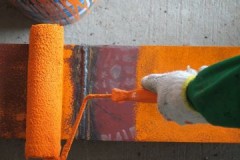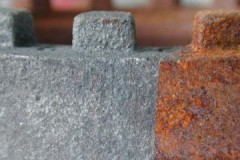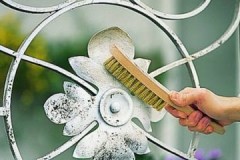Effective methods on how to unscrew a rusty bolt or nut at home
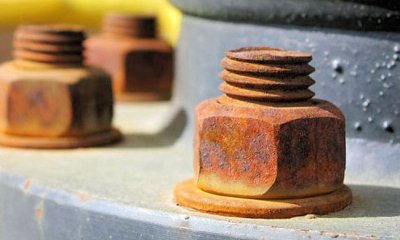 Corrosion is the enemy of many metal products. Nuts and bolts are no exception. Due to rust, the fasteners can turn into a monolith that cannot be disassembled.
Corrosion is the enemy of many metal products. Nuts and bolts are no exception. Due to rust, the fasteners can turn into a monolith that cannot be disassembled.
To solve this problem, use a variety of mechanical and chemical methods. They help break or dissolve the hard oxide layer.
Let's find out how you can unscrew a rusty bolt or nut that won't unscrew at home.
Content
Unscrewing aids
Plumbers and auto repair technicians offer simple and effective methods for loosening rusted bolts and nuts. They are proven by practice and will help in cases where the wrench does not cope with the task.
Lever arm
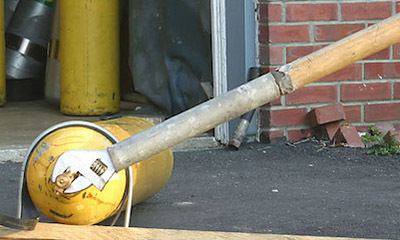 The popular and easy way to go first... First, the junction is cleaned with a metal brush.
The popular and easy way to go first... First, the junction is cleaned with a metal brush.
Next, a pipe is put on the wrench, which will act as a lever. For work, it is advisable to take a spanner wrench, since the open-end wrench can slide off the bolt head.
The part is turned by gently pressing the lever... It is important to control the pressure and speed of movement.
To make the stuck nut turn more easily, it is recommended to lubricate the junction with turpentine or oleic acid.
Chisel
This mechanical trick is used to pull a rusty bolt out of its socket with one blow. The method is quick, but technically difficult. Therefore, only masters who know how to measure the strength and direction of the blow can perform it.
To prevent the percussion tool from slipping, it is advisable to choose a chisel with a wide striking part... As a result of a sharp strong impact, the bolt can be torn off.
Tapping
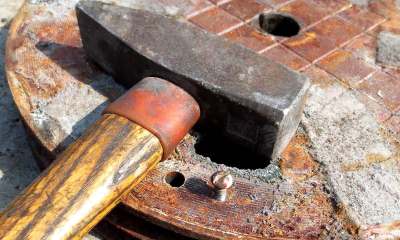 This method is available due to its simplicity. It is often used as a preparation for further processing of the oxidized compound.
This method is available due to its simplicity. It is often used as a preparation for further processing of the oxidized compound.
Tapping to break up the rust layer and make loosening easier... The stuck product is hit with a hammer using a non-ferrous metal guide.
After tapping, loosening can be applied.To do this, first try to tighten the part more, and then relax. This adjustment of the threaded connection helps to achieve the result.
Heating
The thermal method is considered effective, especially if it is used in combination with other mechanical methods. As a result of heating, "sticky" oxides become more brittle and the part lends itself to turning.
To warm up the fastener connection use:
- soldering iron,
- gas burner,
- a candle
- lighter.
The heat source is brought to the problem area and heated. Then, without waiting for cooling, they try to unscrew the nut or bolt.
How to unscrew a rusty bolt or nut by heating, the video will tell you:
Petrol
Refined petroleum products, including gasoline and diesel fuel, help soften the compound clogged with oxides and dirt. The attachment point is abundantly moistened with liquid and wait a quarter of an hour.
After gasoline penetrates into the inter-threaded space, the part is twisted in a standard way using a wrench. The method helps if the corrosion process has begun recently and the rust layer is still insignificant.
WD-40
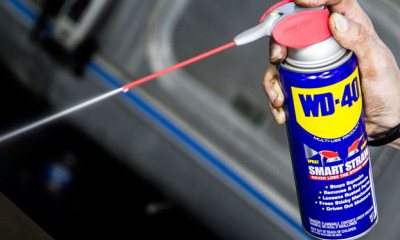 A versatile product often used in workshops, it also helps to unscrew a rusty bolt or nut.
A versatile product often used in workshops, it also helps to unscrew a rusty bolt or nut.
The complex of active substances WD-40, which contains white spirit, ensures the destruction of rusty deposits in the threads.
The method is popular and simple, if this liquid is at hand. WD-40 is sprayed onto problematic fasteners and waited for 15-20 minutes. After that, the part is unscrewed in the usual way.
Kerosene
The action of this substance is similar to gasoline.... Kerosene not only loosens the rusty layer, but also dissolves dirt trapped in the threads. The method is effective if the bolt or nut is in a locked state for a short time.
A combination of methods must be used for heavily rusted mountings. For example, first processing with kerosene, and then unscrewing with a lever. The attachment point is moistened with kerosene, covered with a rag, which is pre-soaked with the same liquid and kept for 15-20 minutes.
Brake fluid
This substance has good penetrating properties.... It softens rust and lubricates threads. Through these processes, a stuck bolt or nut can be loosened faster. Both new and used brake fluid are suitable for work.
Converter
This category of agents includes chemical solutions that react with iron oxides and convert them into safe compounds. The latter form a sticky layer on the metal surface and thus protect it from re-corrosion.
The transducers include:
- organic and inorganic acids,
- corrosion inhibitors,
- metal passivators.
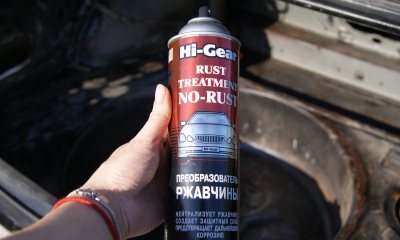 For work, liquid, gel and aerosol converters can be used, which use according to the instructions:
For work, liquid, gel and aerosol converters can be used, which use according to the instructions:
- Rust Treatment No-Rust.
- ASTROhim Antiruster.
- Lavr.
- RUNWAY.
- FENOM.
Vinegar
Low-concentration table vinegar can dissolve the metal oxide. The effect is based on the chemical reaction of acetic acid with iron oxides and hydroxides. The vinegar treatment is popular in removing rust from metal surfaces due to its effectiveness.
Fasteners that cannot be untwisted are poured with vinegar and covered with a rag soaked in it... The holding time depends on the degree of damage to the thread. On average, it ranges from 30 minutes to several hours. Periodically, during the soaking process, the flexibility of the fastening is checked using a wrench.
He will tell you how to use vinegar to fight rust this article.
Soda
Sodium bicarbonate is often used to remove rust from exposed surfaces. We apply this method also for stuck threaded fasteners, however its effectiveness is significantly lower compared to other methods.
Coca Cola
 Carbonated drinks made with phosphoric acid are widely used in everyday life and in workshops.
Carbonated drinks made with phosphoric acid are widely used in everyday life and in workshops.
With the help of cola, pepsi, forfeits it is possible to dissolve rusty plaque and thus facilitate the loosening of bolts and nuts.
The locked mount is poured over with Coca-Cola and covered with a rag that is abundantly soaked in the drink. After 20-30 minutes, they begin to check the result of the reaction. If the screw does not give way, continue soaking.
You can learn how to use Coca-Cola in the fight against rust here.
Lemon juice
Natural citrus juice contains citric acid, which reacts with oxides to convert them into salts. Lemon juice can be substituted with crystalline citric acid.
To prepare the reagent, a little water is added to the powder to form a concentrated solution. Next, the liquid is applied to a rusty bolt and rags. Cover the fastener with a soaked cloth and keep it for 2-3 hours. If the product cannot be loosened, continue soaking.
You can learn how to use citric acid against rust. here.
Sulfuric acid and zinc
This method is based on the creation of a galvanic cell... The method is effective, but requires the availability of the necessary reagents and careful handling.
 A low plasticine or wax side is made around the blocked connection.
A low plasticine or wax side is made around the blocked connection.
A small plate of zinc is placed in an impromptu cup and sulfuric acid is poured, which reacts with oxides and reduces the oxidized metal.
Zinc, as a more active element, serves as the basis for the reaction, due to this, the destruction of the nut itself is not observed. Depending on the thickness of the rust, the reaction takes from 12 to 24 hours.
Sulfuric acid requires careful application... It is important to follow safety precautions so that liquid does not get on the skin.
Special compounds to remove corrosion
In addition to converters, you can find special compounds designed to remove rust in stores. They also help to ease the loosening of corroded bolts and nuts.
The most demanded universal remedies are:
- A liquid containing citric acid. Available as a spray.
- Rust remover B-52 Top. The gel removes rust from the surface of iron, copper, alloys.
- Neomid Anti-rust. Concentrated compound that not only breaks down rust, but also creates a protective coating.
- Anti-Rust Brulex. It has excellent penetration even into old rust layers.
Liquid Penetrant Test in Video:
Prohibited methods
To unscrew a rusty screw, you need to weigh the pros and cons. This will allow you to choose the optimal solution to the problem. Although mechanical methods are applicable in some situations, it is not recommended to use excessive force.
Additional Tips
In order for the procedure for unscrewing the nut to give a positive result, it is useful to take into account additional recommendations. They concern not only the destruction of the rusty layer inside the fasteners, but also the actual screwing of the bolt itself. Often, the problem is aggravated by the fact that the screw was initially tightened in violation of the technology.
It is important to remember that:
 Do not use dirty or rusty parts, or use excessive force when tightening.
Do not use dirty or rusty parts, or use excessive force when tightening.- It is useful to treat the bolts with silicone, grease or graphite grease before tightening.
- It is recommended to clean the outside of the fasteners with a wire brush before using any anti-corrosion agent.
- If one method does not work, repeat it or use an alternative method.
Conclusion
Rusty threaded products lend themselves to loosening using special tools and methods. This can be a mechanical effect on a bolt or nut, a folk remedy or a special chemical composition.
The method is chosen, focusing on the degree of blocking of the connection, the availability of funds, as well as plumbing experience.

